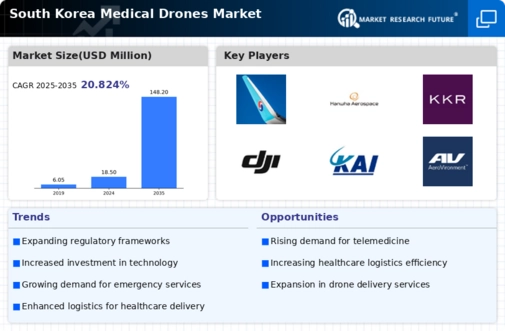The medical drones market in South Korea is currently characterized by a dynamic competitive landscape, driven by technological advancements and increasing demand for efficient healthcare logistics. Key players such as Zipline (US), Matternet (US), and Wingcopter (DE) are at the forefront, each adopting distinct strategies to enhance their market presence. Zipline (US) has focused on expanding its operational footprint through strategic partnerships with local healthcare providers, thereby enhancing its service delivery capabilities. Meanwhile, Matternet (US) emphasizes innovation in drone technology, particularly in payload capacity and flight range, which positions it favorably against competitors. Wingcopter (DE) is leveraging its expertise in vertical take-off and landing (VTOL) technology to penetrate underserved regions, indicating a trend towards regional expansion and tailored solutions.
The business tactics employed by these companies reflect a concerted effort to optimize supply chains and localize manufacturing processes. The market structure appears moderately fragmented, with several players vying for dominance. However, the collective influence of these key players is shaping a competitive environment that encourages collaboration and innovation, as companies seek to differentiate themselves through advanced technology and operational efficiency.
In October 2025, Zipline (US) announced a partnership with a major South Korean healthcare provider to enhance its drone delivery network, which is expected to significantly reduce delivery times for critical medical supplies. This strategic move underscores Zipline's commitment to improving healthcare logistics and demonstrates the potential for rapid scalability in urban areas. The partnership is likely to enhance Zipline's competitive edge by integrating local knowledge and resources into its operations.
In September 2025, Matternet (US) launched a new drone model designed specifically for urban environments, featuring advanced navigation systems and increased payload capacity. This development is pivotal as it aligns with the growing demand for efficient urban logistics solutions, potentially positioning Matternet as a leader in the urban medical delivery segment. The introduction of this model may also stimulate further innovation within the industry, prompting competitors to enhance their offerings.
In August 2025, Wingcopter (DE) secured a contract with a South Korean government agency to deploy its drones for rural healthcare delivery. This contract not only highlights the increasing recognition of drone technology in public health initiatives but also reflects a broader trend towards government support for innovative logistics solutions. Wingcopter's ability to address rural healthcare challenges could set a precedent for future projects, emphasizing the importance of accessibility in healthcare delivery.
As of November 2025, the competitive trends in the medical drones market are increasingly defined by digitalization, sustainability, and the integration of artificial intelligence (AI) into operations. Strategic alliances are becoming more prevalent, as companies recognize the value of collaboration in enhancing technological capabilities and market reach. Looking ahead, it is anticipated that competitive differentiation will increasingly pivot from price-based strategies to a focus on innovation, technological advancements, and the reliability of supply chains. This shift may redefine the competitive landscape, fostering an environment where companies that prioritize cutting-edge solutions and operational excellence will thrive.

















Leave a Comment